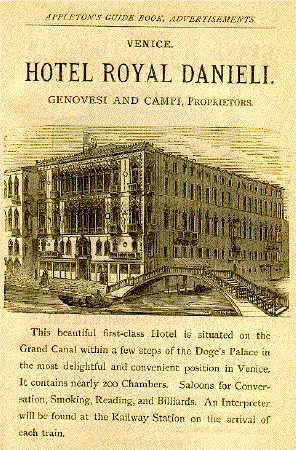| "Milan," "Rome," and "Constantinople"; excerpts from Appleton's European Guide Book for English-Speaking Travellers, Part II | ||
Milan
 [Description: Advertisement for the
Hotel Royal Danieli in Venice]
[Description: Advertisement for the
Hotel Royal Danieli in Venice]
[from the section on Milan] "The Last Supper," by Leonardo da Vinci, is in the former refectory of the Dominican Convent attached to Santa Maria. It has suffered much from dampness, injudicious attempts at restoration, and other ill usage. "At the time that Milan was in the possession of Napoleon, this convent was converted into barracks, and as the refrectory became a stable for the calvary horses, the already mutilated painting received still further injury. Many anecdotes are related of Leonardo da Vinci during the progress of his picture. It is said that the head of our Saviour was left unfinished; the artist, having invested the countenance of the disciple John with a beauty almost divine, shrank from portraying the mingled
"The purpose being the decoration of a refectory in a rich convent, the chamber lofty and spacious, Leonardo has adopted the usual arrangement: the table runs across from side to side, filling up the whole extent of the wall, and the figures, being above the eye, and to be viewed from a distance, are colossal; they would otherwise have appeared smaller than the real personages seated at the tables below. The moment selected is the utterance of the words, 'Verily, verily, I say unto you, that one of you shall betray me;' or rather, the words have just been uttered, and the picture expresses their effect on the different auditors. The intellectual elevation, the fineness of nature, the benign god-like dignity, suffused with the profoundest sorrow, in the head of Christ, surpassed all I could have conceived as possible in art; and faded as it is, the character there, being stamped on it by the soul, not the hand, of the artist, will remain while a line or hue remains visible. It is a divine shadow, and until it fades into nothing, and disappears into nothing, will have the lineaments of divinity...." — Jameson.
"Leonardo said that he had meditated for two whole years how best to portray on a human face the working of the perfidious heart of Judas; it is believed that he took for his model the prior of the convent, his bitter and malicious enemy."
| "Milan," "Rome," and "Constantinople"; excerpts from Appleton's European Guide Book for English-Speaking Travellers, Part II | ||